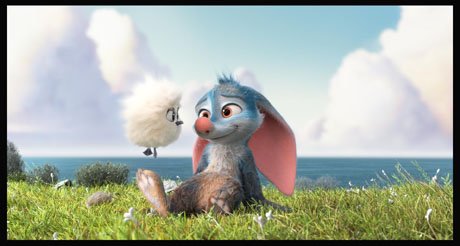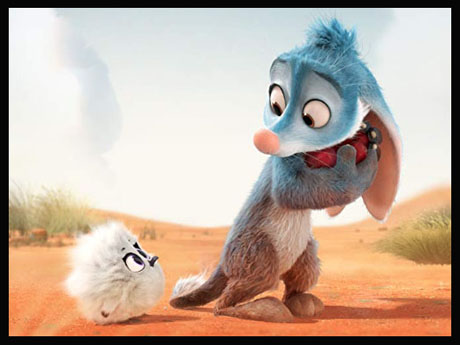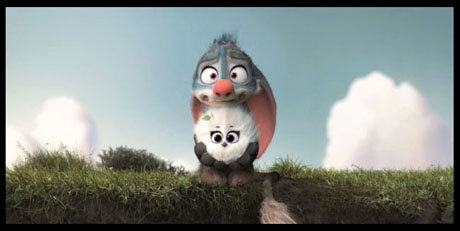
After years of producing award-winning feature-length films, DreamWorks Animation announced they were getting into the “shorts” business in November 2017. And this year their first two short films have made it onto the finalists list for the Best Animated Short Film Oscar. One of the entries is Bilby, which emerged from the DWA feature “Larrikins”, a casualty of Universal’s purchase of DWA in 2016. The trio of directors of the short reflect on their amazing journey with this story of two unlikely friends.
Jackson Murphy: Congrats on being on the Top 10 shortlist.
JP Sans: I don’t know how it feels yet. I’m still numb about it. I’ll let you know when it kicks in.
Pierre Perifel: It’s amazing. And we’re really looking forward to the 22nd, because that’s when we know about the nominations. Hopefully… we can get in there. Fingers crossed. But super exciting.

JM: A few years ago, there was DreamWorks animated film in development called “Larrikins” – an Australian outback musical. Production was cancelled on that, but yet – out of it – came this short, Bilby. So Liron, take me from that point of the cancellation of “Larrikins” to being able to start up and make “Bilby”.
Liron Topaz: The three of us worked on “Larrikins”. We worked on it for quite a bit of time. Pierre, for example, from the very beginning – from the ground up – was building and developing all these characters and this entire world. And at one point, the studio decided to stop production on this film. And these things happen. There’s a lot of different factors that go into these things, and we understand this.
But we put so much of ourselves into this process – and we put so much of our hearts and souls into this development – that we felt very heartbroken. We really wanted to make something out of it. For me, personally, it was such an amazing world that we really wanted to show everybody what this world could be.
So when they decided to cancel it, at the same time the studio opened the shorts program. And we thought, “Wouldn’t this be a great idea to utilize these bad things that happened into a great thing?” We pitched the idea. And actually at that point we already had the story – we wanted to tell our new story through these characters and this world. And we basically pitched a full running animatic to the development team. And they really liked the idea of doing a short with it, and they really liked the story.
We got the green light, and we started. I think we were the last pitch in the program, but I think we were the first one to go into production. And it was amazing. Basically, we just wanted people to see this – to see this world and these characters.

JM: Wow. That’s an incredible story. Pierre, how does it feel to get a second chance with these characters, this concept – getting that opportunity?
PP: It was… Liron really instigated the whole thing. JP and I were more… we had been working on “Larrikins” for a long, long time, so when that got stopped it was hard for us. We kind of decided to move on. And then [Liron] came and he was like, “Guys – I’ve got an idea of making a short film with it. Would you be up for it?” And at first we were like, “Oh, no, man. It was too hard.” And then he pitched the idea of “Bilby”, and we were like, “Oh, dude. It’s great. Let’s do it.”
And that felt awesome – because then it was the three of us working for a couple weeks in order to make that deadline for the last pitch of the short film program. So we worked around the clock, basically in the same little room, like three students who were back at school. Ideas, drawings, storyboards… cutting it together with sound. It felt very energetic and pumped us up big time, once again to get back on our feet. And the fact that we got green lit and that we could go ahead and being able to showcase these characters and give them a new life. Actually, we kind of changed their personalities quite a bit. But that energy was just really beneficial to us.
JM: It’s so cool and great that you guys got the chance to do this. And out of all the animated shorts I’ve watched over the past year, this has to be the sweetest of them all. JP, describe the sweet relationship between Bilby and the Baby Albatross.
JPS: When [Liron] pitched us this original concept, I got hooked right away because we’ve been on this project for so long, and we’ve been building these characters, that we fell in love with who these characters could be. The idea of creating something for the world to see – what so many people worked so hard on – was already exciting enough. But at least for me, on a personal level, I connected to what the idea could be.
We’re all fathers. We’re all parents. And we would do anything for our child – absolutely anything. And instantly I connected with that – even though the story grew from that. From the beginning, the idea of this character, Bilby, living in this world which is so dangerous and inhabitable in a way – and meeting this really cute baby bird who really has no hope of living. [Bilby] has sort of lived by himself because that’s the only way you could survive in this world – and having to just go out on a limb and try to help this baby bird that will absolutely die if he walks away… for us it was such a great contrast to tell that story.
To showcase how a character, even though from the very beginning he’s taught to survive by being alone and a little bit selfish – to open his heart and what great things can come out of it. And at the end, it was really important for us to show that out of this deed of helping this baby bird, he became a parent. He became his best friend and a long life family because of it. To me, that’s such a great story aspect – and the growth of these two characters, especially Bilby.
JM: I love the relationship. And you’re right – it’s very dangerous in the Australian outback. There’s a sequence in “Bilby” that blew my mind. It’s a continuous shot/montage – the two of them are running trying to get out of all these dangerous situations. Liron, how did you create that specific sequence?
LT: The funny thing is, when I first thought about the idea, I actually wrote it down – a rough outline of the story. And at that point, I think I wrote, “And then there’s a montage of a lot of dangerous animals – one after another – and it gets shorter and shorter.” But besides that, we didn’t really know what’s happening at that moment. So, we knew we needed that for the story… and the relationship, to get closer and for Bilby to start caring about this bird (because he starts off in the montage wanting to get rid of the bird, and at the end, he’s protecting the bird).
So there’s a big shift in their relationship through that montage. But the idea was to show how ridiculously dangerous this world could be. So we basically started brainstorming – hours after hours – of animals and environments we could use. (At one point we ran out of animals.) Fire? Water? Different elements? The big trick was: how could we connect them together? How do we tell something that feels chaotic and very dangerous, but also is very clear and easy to follow?
As we start progressing in the montage, it becomes faster and faster. And their space – how we transition from shot to shot – they become closer and closer… until at the end they’re almost at the exact same point. And at that point, it becomes almost like an animation flipbook. And I think that’s what people really like about that idea. You start getting all these ideas without really realizing what you’re looking at. We thought it was a lot of fun – and probably the part that changed the most from beginning until the end. We just kept editing it and kept iterating and changing it until it was just right for us.

JM: It is really well done. Definitely one of the highlights of “Bilby”. Purple is my favorite color, so seeing the purple eyes of the Baby Albatross was great. Pierre, tell me about choosing purple eyes for the Baby Albatross.
PP: Her eyes were [originally] blue, but I think we wanted something a little more whimsical. We make films for children, so I think we can afford a bit more fantasy. I kind of like the idea that it comes from anime influences.
JPS: I remember the bird’s eyes were kind of originally baby blue, and we talked about, how could there be more of a whimsical, magical thing to her? I remember on Friday, at the very last minute, we told our art director, “Is there any way you could shift the eye color? Let’s just brainstorm.” Over the weekend, we made four different images – with four different eye colors. Literally, it was from blue to purple. I don’t think you could tell the difference. A, B, C and D looked almost exactly the same. But all weekend… we were like, “No, B. No wait – wait – C.”
PP: I think we also wanted to make a baby girl. With blue – you didn’t really know. And for me, it was actually a baby boy. It’s very charming, I think.
JM: Yeah, perfect choice. And whimsy is the right word for that. JP, there’s a lot of epic music in “Bilby”. Tell me about getting the right person for that. And since “Larrikins” was going to be a musical, was there any consideration about doing a song in “Bilby” as well?
JPS: Great question. The main we wanted to do was no dialogue because we wanted to keep this short very universal for everybody. And also from being in animation, having no dialogue really gave us a lot of freedom for what we like the most in animation, which is acting out with the physical aspects of the expressions, emotions and poses. We knew that the music was going to be absolutely very important because it would tie everything together.
We also wanted the music to really involve a theme between the two of them and when they connect and make this bond. We were really lucky to get Ben Wallfisch. He was in talks with the studio at the time. And he was coming off a really project. We were allowed to pitch him the idea of what the short would be and see if he was interested in doing it. And he had been toying with something in animation – he had been wanting to do something.
We pitched him the same pitch we did for development, and as soon as it was over, he got it right away. Immediately. He was actually, at the time, he was going to have a baby as well. He got the relationship between the parenthood – and about the love of a family and doing anything it takes for them. And as soon as he got it, we knew he was the right guy. He started talking to us and brainstorming on very similar things that we were looking for in the music. We feel so honored that someone like Ben Wallfisch wanted to work on this short because he brought so much of the emotion that we wanted to tell through these characters.
And on the “Larrikins” side, what was great about “Larrikins” – that musical aspect of it. We love that project because it was very unique in that way. Because of the short and because of the story we wanted to tell, it had to be our own thing. I don’t think we thought, ever, of a song in this short. Because we didn’t want any dialogue, I think it lends itself to a score that Ben Wallfisch wrote for us.
PP: And we started with temp music that was very Australian inspired. Didgeridoos and drums. Very high-paced rhythm. We took that and made it so… epic.
JM: Yeah, it’s epic. It’s grand in scale. Australia is known for its laid-back, positive, fun vibe. Would you say working on “Bilby” was as laid-back and fun as it could get, or were there also some tough days working on this?
JPS: It was so much fun. I think the great thing about this experience… was that everybody was very excited to work on this short. And we wanted to make sure that the people that were excited about it would work on it. We got so lucky to have incredible artists work on it but also the energy and inspiration they had for it – and how much they put themselves into it. It was an honor for us. As artists, we know that as important as it is to have a really good story and a really good film, it’s also important to have a lot of fun in the project. It feels like that’s when you put your best foot forward.
That was equally important as to telling to the story. We wanted to make sure everybody felt like it was their own short – their own story. It wasn’t just ours, it was everybody’s. I feel like because of that, we had so much fun. And every single artist, from the technical to the artistic, put so much of their voice into it. And I think it made the short what it is. And because everybody was having so much, I can’t remember laughing so much in a 9-month span. We would go to tears sometimes… just crying… the jokes and the energy that was in the room.
PP: The cool thing was that the studio actually gave us complete creative freedom. There were barely any notes coming from the direction of the studio or the executives. So we went to town to it.
JM: After all you guys went through with “Larrikins”, for them to give you total control and freedom on everything, that’s wonderful.
- INTERVIEW: Inside The Music Of Pixar’s “Dream Productions” - December 11, 2024
- INTERVIEW: The World Of “Au Revoir Mon Monde” - December 4, 2024
- INTERVIEW: Precious Details On “The Lord Of The Rings: The War Of The Rohirrim” - December 2, 2024


 January 9th, 2019
January 9th, 2019  Jackson Murphy
Jackson Murphy  Posted in
Posted in  Tags:
Tags: 






